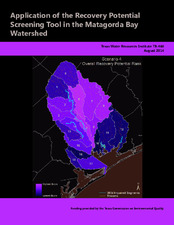| dc.description.abstract | The State of Texas currently contains 568 water bodies considered impaired due to excessive pollutant loading. Of these, approximately 48% are impaired due to elevated levels of fecal indicator bacteria from animals, birds and humans. Once impaired, efforts to restore water quality must be undertaken. This large number of bacteria impairments leaves the State with a sizable task ahead and presents a range of restoration challenges. Restoring all of these impaired water bodies is costly and resource intensive, thus prioritizing future water quality restoration efforts is a means to efficiently allocate available resources and achieve timely restoration results.
The U.S. Environmental Protection Agency (EPA) developed the Recovery Potential Screening (RPS) tool to help prioritize water body restoration planning efforts (Norton et al. 2009). Built as a technical aid for states and government agencies, the RPS tool provides a systematic approach for comparing the relative restorability of water bodies. When employed and supplied with sufficient data, this tool can aid groups and entities considering restoration efforts determine which water bodies have the highest likelihood of successful water quality restoration based on characteristics of the local watershed (U.S. EPA 2014). | en |


